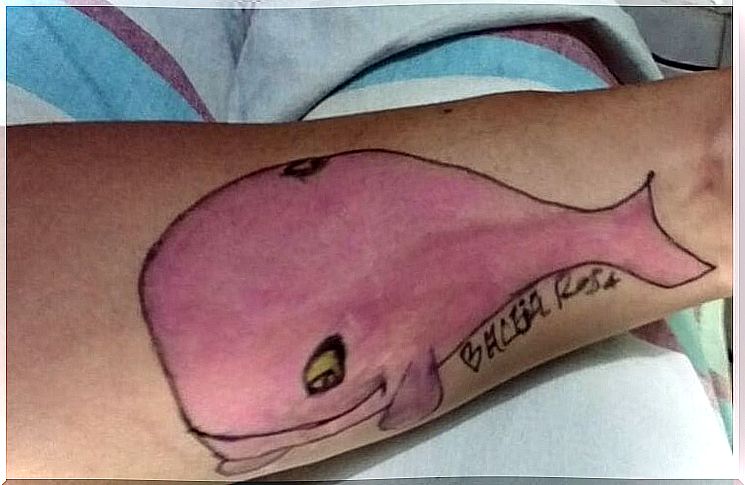The Game Of The Blue Whale: Suicide In Children
Nobody wants to commit suicide. Most people who take this step are actually convinced that they have no other possible way out. It is their last refuge, the last place they turn to escape a painful life. The grim play of the “blue whale” baffles most of us. But this is a crucial point. Today, thousands of children in our world float in the murky waters of sadness, loneliness and vulnerability. They need help.
Maylen was thirteen years old and lived in a small town in Colombia. Her life seemed normal. It differed little from all other children of the same age. A few days before she committed suicide by hanging herself with a belt, she asked her mother if blue whales existed. Mrs. Villamizar replied, “They exist and probably not many left. They are dying out.” She couldn’t possibly have imagined what her daughter had in mind.
Maylen is not alone in taking this step. Nearly one hundred and thirty young people around the world have fully performed the fifty terrible steps of this “game”.
In this game you win by completing a “final mission”. This mission is to take your own life. But the horror is even more horrifying. Because if they don’t, the game will send them a warning as soon as it discovers their IP address. The message is that other people can kill their friends and relatives.
Many people will say that the world of social media and virtual communities is evil. But behind it all, there’s one particular thought that stands out: Believe it or not, the world is full of blue whales. They are precious, vulnerable creatures. They represent those things that we unconsciously or intentionally neglect: loneliness, fear, insecurity…
It’s time to make a decision. The opposite of the “blue whale” is the “pink whale.” The pink whale is a wonderful initiative. It arose as a response to the blue whale’s game. Because this game unfortunately robs very young people of their lives.
Blue whales try to escape a painful life
Oddly enough, the name of the game has very little to do with the precious animal whose name it bears. The blue whale is the largest animal on our planet. They are graceful swimmers and they traverse the oceans very quickly.
They are also the loudest animals on our planet. For they can emit vibrations, hums and moans. These sounds can be heard from more than 1,400 kilometers away. This whale is probably one of the most fascinating creatures in nature.
But our “blue” whales are swimming on asphalt and in the social media world. They are silent beings. We don’t notice these people either. Characteristics of these people are a certain psychological vulnerability and a lack of stable role models.
How come youngsters of twelve, thirteen or eighteen years old can come to the decision to play that game? This game asks them to do humiliating painful things. To understand this we have to take into account some aspects.
Why does a young person decide to participate in this game?
The Blue Whale game gives children and teenagers the opportunity to be unique in a world where they feel invisible. Because it’s a world where many of them don’t find their place or discover something that makes them exceptional.
Every act of self-harm, every terrible challenge in which they succeed, becomes an achievement. For them it is heroic deeds. For they have defeated pain, fear, indecision…. They proudly post their “wins.” That way they get some psychological confirmation and motivation. This keeps them motivated to continue.
Moreover, the simple act of starting these kinds of games makes them feel like they are part of something. Because it is a project that requires a commitment. We must not forget that the teenage years are a period of life full of quests. It makes no difference whether or not the young person has a solid group of friends or a family that provides them with stability or security. They will look everywhere for ways to protect themselves from loneliness. And sometimes they look for this in the worst possible places.
Ultimately, the game of the blue whale presents these children and teens with a long journey full of horrific challenges. These challenges will supposedly support their self-esteem. But what the kids don’t know is that they are at the mercy of the sadistic cruel whims of the people behind this game.
A blue whale can become a pink whale
We need to wake up. Because more than one blue whale swims around us. However, you have to be careful not to scare them off. Be careful not to criticize them because they feel what they feel or because they are curious about this game.
For when you punish, judge or mock, the blue whale will swim away from you. You have to guide them in a careful, warm and intelligent way. Thus, with your help, they will turn into a pink whale.
The World Health Organization states that nearly four percent of the population suffers from depression. Every year there are also more than 800,000 people who decide to take their own life. For them, this is the only way to end suffering. A large part of this group are young people between 13 and 25 years old. In addition, there are nearly sixteen million people who self-injure, mostly teenagers.
That is why we need to focus on changing the way we raise and educate our children. In schools we need more tools and definitely more programs like the pink whale challenge. This challenge uses fifty fun tests. The intent is to encourage a positive attitude. Step by step, the children come to a new start in life – and not to an unhappy ending.

Prevention and supervision
The family plays a vital role in these scenarios. So, during this process, let’s pay attention to the following guidelines:
- The parents must be fully available emotionally when they listen to their children.
- The current economic recession in many countries makes it even more difficult for families to spend time together. But the little time we have should be quality. Because in this way we build good trust and confidentiality with the children.
- It is also important that we give children the opportunities and the tools so that they can build meaningful relationships with their peers. But we must always keep an eye on seclusion.
- We also need to remember that it is imperative that we value our children and give them positive reinforcement. Thus, they will have a strong self-esteem.
Finally, we should also pay attention to the changes in their mood and behavior. It is also necessary that we regularly check what they are doing and what or with whom they are sharing things on social media. This part is the key to avoiding situations like the terrible events that are happening all around us and are closer than we think.









